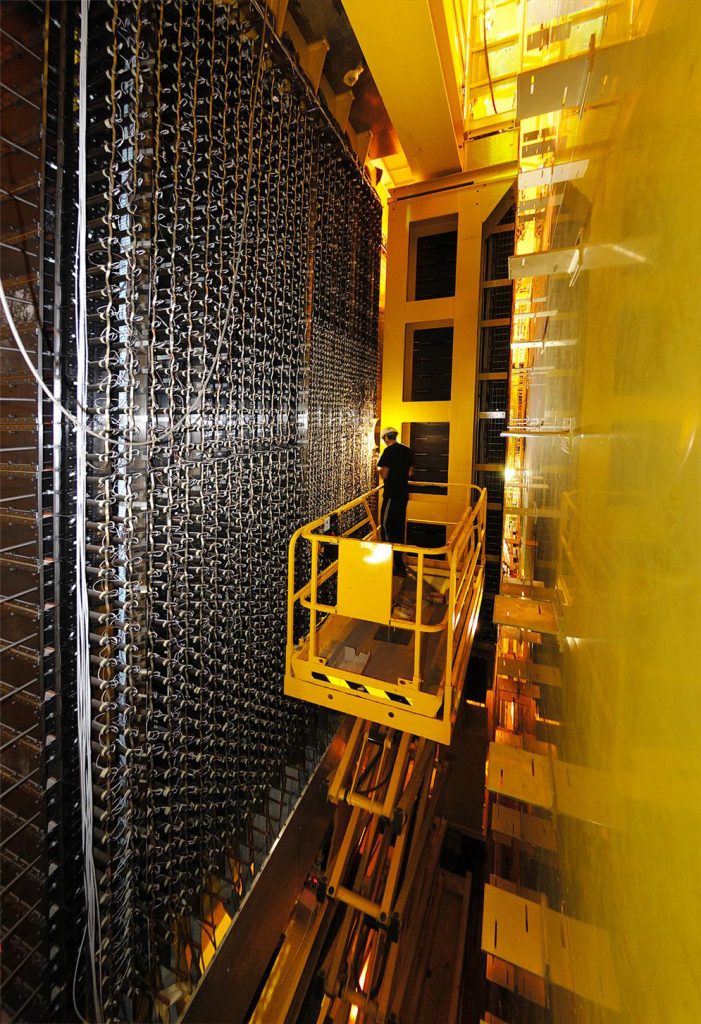
LHCb

6.6.24
The LHCb experiment is revamping its electromagnetic calorimeter with new high-performance modules and equipping its ring-imaging Čerenkov detectors with very fast electronics.

Maintenance of the electromagnetic calorimeter (Image: LHCb collaboration)
On 5 July 2022, protons began colliding again in the LHCb detector after a three-and-a-half-year break known as Long Shutdown 2 (LS2), marking the start of the third run of the Large Hadron Collider (LHC). During this period, the original LHCb detector at the LHC was largely dismantled and an almost completely new detector constructed. The 2020 update of the European Strategy for Particle Physics approved by the CERN Council strongly supported exploiting the full potential of the LHC for studying flavour physics. A further upgrade of the LHCb detector, known as Upgrade II, is planned to allow LHCb to operate at a much higher instantaneous luminosity and cope with the demanding data-taking conditions of the High-Luminosity LHC (HL-LHC). The latest technological developments will be taken into account to design the new detectors.
Electromagnetic calorimeter
![]()
![]()
![]()
The new revolutionary electromagnetic calorimeter being developed for LHCb Upgrade II will be able to precisely measure the arrival time of electromagnetic particles. Its test measurements demonstrated detection of high-energy electrons within 20 picoseconds of precision. This is the first time that such excellent performance has been achieved with an electromagnetic calorimeter in particle physics. The new calorimeter will have finer granularity, enabling it to cope with a much higher particle density at higher instantaneous luminosity. Luminosity is an important indicator of the performance of an accelerator: it is proportional to the number of particle collisions that occur in a given amount of time.
The technology for the new LHCb calorimeter modules is based on the “Spaghetti Calorimeter” (SpaCal) concept, in which the scintillators resemble strands of spaghetti. These scintillating fibres are housed in the 5180 longitudinal holes in the SpaCal module. The calorimeter is constructed with modules with two types of absorbers: tungsten-based SpaCal-W modules, which will be built using tungsten 3D-printing technology, and lead-based SpaCal-Pb modules.
The number of particles crossing the detector is extremely high in the central region surrounding the beam pipe, inside which the proton beams of the LHC circulate. The current LHCb calorimeter is composed of Shashlik modules. The performance of these modules decreases over time due to radiation damage caused by the large flux of particles when the LHC is running. During the next Long Shutdown, these degraded Shashlik modules in the very central region around the LHC beampipe will be replaced with 32 SpaCal-W modules, and an additional 144 SpaCal-Pb modules will be placed around them.
Ring-imaging Čerenkov system
![]()
![]()
![]()
![]()
In the upgrade of the ring-imaging Čerenkov (RICH) system, the whole electronics chain will be replaced. The detector will be equipped with a high-rate data acquisition system and a novel readout application-specific integrated circuit, called FastRICH, which is capable of providing precise timestamps of Čerenkov photons. These photons are produced when electrically charged particles, such as protons or electrons, travel faster than light in a medium.
The new LHCb RICH will be the first system featuring fast timing capabilities for single photons at the hundred-picosecond level, demonstrating once again how the challenging conditions of a flavour physics experiment at the LHC can lead to technological breakthroughs.
Prototypes of both subdetectors, SpaCal and RICH, have been successfully tested at CERN’s accelerator complex with beams from the Super Proton Synchrotron in preparation for the HL-LHC era.

See the full article here.
Comments are invited and will be appreciated, especially if the reader finds any errors which I can correct.
five-ways-keep-your-child-safe-school-shootings
Please help promote STEM in your local schools.
Meet CERN (CH).



